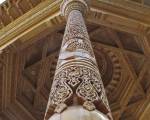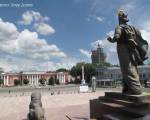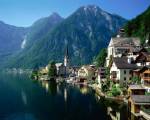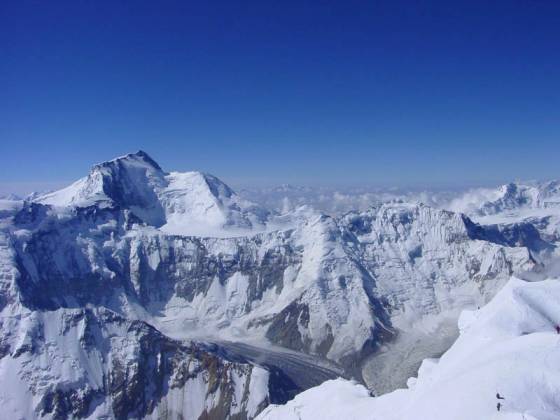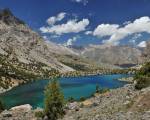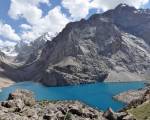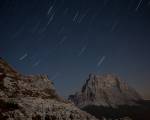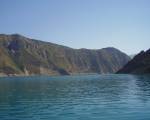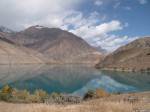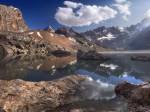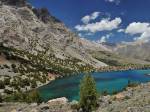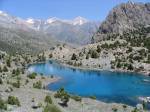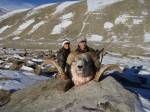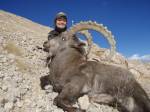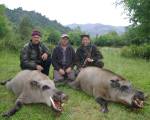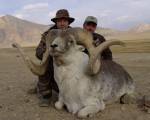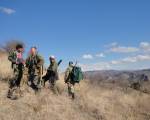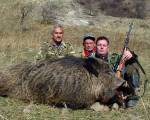TAJIKISTAN: TOURISM OPPORTUNITIES
Situated in the heart of Central Asia and along the ancient Silk Road, Tajikistan borders Afghanistan in the South, China in the East and Kyrgyzstan and Uzbekistan in the North and West. With more than 93% of it's 143'000 km2 mountainous and over 50% of its territory lying above 3000m, Tajikistan offers an impressive range of unique landscapes and climatic zones: from subtropical heat to arctic cold, from hot deserts to huge icy plateaus. Tajikistan is endowed with a stunning variety of flora and fauna and is rich in striking contrasts. The country is home to the highest mountain of the former Soviet Union, the Peak Ismoili Somoni (formerly peak Communism, 7495 m) as well as to its longest glacier (77km), named after the 19 century explorer Fedchenko.
Tajikistan's history reaches back to the stone age, is linked to names like Cyrus and Darius, Alexander the Great, Marco Polo and Tamerlan and lived through the invasions of Arabs, Turks and Mongols.
Therefore a wide diversity of people and cultures is evident in different parts of the country. There are Tajiks, Kyrgyzs, Uzbeks, Russians, Tatars, Germans and other nationalities with an astonishing diversity in dialects and even languages (e.g. Badakhshani, Yaghnobi). The Tajiks themselves emerged from a succession of Iranian nations in the region over the past 2500 years, including the Bactrians, Sogdians, Parthians, Khorezmians and Scythes.
Tajikistan is not only beautiful but also a place of genuine, unadulterated hospitality. Further you will find useful detailed information on different tourist corners and spots of Tajikistan throughout the country.
SOMONI AND KORZHENEVSKAYA PEAKS
Somoni Peak (Peak Communism), 7,495 m., is located at the crossing point of the Academy of Sciences and Peter the First Ridges. Full deciphering of this mountain knot - "Garmo knot" - was finished in 1932. At that time the peak elevation was identified, previously confused with Garmo Peak. The first climb took place in 1933 and the top was named after Stalin. Later the peak was renamed and till 1999 was known as Peak Communism. At present, the peak is named Ismoili Somoni Peak.
An adventurous yet a rather complex route lead to the pioneer's glade - "Ice Camp" situated at the elevation of 4,600 meters. This is the place from where the first climb was exercised to the highest top of Central Pamirs. The base camp now is called "Altyn Mazar". The route covers one of the largest glaciers - Fedchenko Glacier, its left affluent Bivachny, and further goes to the upper part of Ordzhonikidze Glacier.
The key route point is fording the wild water of the Seldarah River taking off Fedchenko Glacier. Experienced guides and strong horses will help you here. There exist several routes leading to the top: all tried at different times and of different complexity categories - from 5 A to 6 B. The most popular are: Borodkin route from the north (from Valter Glacier; done on August 17, 1968; category 5 A) and the one from the west along "Burevestnik" rib (from Fortambek Glacier; done on August 20, 1968, category 5 A). In the north, a base camp is situated on Moskvin Meadow between the glaciers Valter and Moskvin at the elevation of 4,300 meters. From here you can climb Korzhenevskaya Peak (7,105), and also peaks of The Four (6,300), Pierre d'Kubertain (5,700), and Vorobyov (5,200).
Base camps are reached by helicopters from Dushanbe. To get better adapted, we suggest you should take a hiking tour from the village of Dipshar to Moskvin Meadow. The trip takes 5-6 days. It will give you enough time to get adapted to mountain conditions and enjoy the beauty of Pamirs.
In the west, the base camp is located at Suloev Meadow near Fortambek Glacier at the elevation of 3,900 meters. You can also take a walking tour while a helicopter will take the cargo to the base. The peculiarity of climbing Ismoil Somoni Peak is that you practically walk along the whole Pamirs Firn Plato.
Communism Peak is the highest peak on the territory of former USSR; very impressive and well-known one, that is located in the Northern-West part of Pamir. The peak was discovered in 1928, during Soviet-German scientific expedition and at first till 1962 was called Stalin peak, then it was renamed as Communism Peak. In 1999 when Tajikistan became an independent state it was renamed again as Ismoili Somoni peak, in honor of the founder of the first Tajik statehood (X century). The capital of Tajikistan - Dushanbe - is the departure point of the expedition. The most convenient option of approach is the option of arrival to Dushanbe by international flights, for present there are international flights from Istanbul, Munich and Moscow. There is only one possible option of getting to the Base camp from Dushanbe for present - a helicopter flight. Now there are no any opportunities for walking passing that was possible several years ago because of difficulties of passing.
There are two options of getting to the Base camp on Moskvina Glade:
- Directly from Dushanbe;
- By car from Djirgital and further flight.
The Base camp is on the height of 4200 m. above sea level, near the confluence of the glaciers Walter and Moskvina (the Eastern branches of the glacier Fortambek). It's the most convenient and safe departure point for ascending to Communism and Korjenevskaya peaks because of the shorter approaches. After the flight to the Base camp we recommend you to make a wonderful 2-4 days long trip via the glacier Fortambek to Suloeva glade. You can enjoy the views of such Pamir giants, as Russia peak, Moscow peak, the glacier Tramplinnyi - the spring of continual falling avalanches.
Vorob'eva peak (5691 m) and Chetyreh peak (6299 m) are used for acclimatization very often. They are located quite nearby the Base camp. It's possible to ascend to Vorob'eva peak for one day, to Chetyreh peak - for 2-3 days. The two peaks - Vorob'eva and Chetyreh have many points of visibility. You can see fantastic panoramas to the surrounding peaks, especially to the highest of them: Communism and Korjenevskaya peaks. You have to take into account the altitude of Communism peak overtops 7000 m and that's implies high-altitude climbing. The route to the top is technically difficult and existence of such crafty factors as unpredictable weather and pressing height can play a determinative role in success or failure of your expedition. For successful expedition you would be required good physical training, essential equipment and correct acclimatization.
The peak was discovered by Russian scientist and geographer N. Korjenevskiy in 23rd of August in 1910 and was called in honour of the wife of the investigator - Evgeniya Korjenevskaya. The name Korjenevskaya Peak appeared on the geographical maps officially since 1927. The first successful ascent to the top was in 22nd of August in 1953. The group consisted of eight mountain-climbers from Leningrad reached the top, ascending along the Northern edge from the glacier Korjenevskaya. For present there are known about 10 different routes of different difficulties leading to the summit. The safest and less difficult route is the route along the Southern edge from the glacier Korjenevskaya.
The capital of Tajikistan - Dushanbe - is the departure point of the expedition. The most convenient option of approach is the option of arrival to Dushanbe by international flights, for present there are international flights from Istanbul, Munich, and Moscow. The option of arrival to Dushanbe from Tashkent (via Samarkand) seems interesting for those who want to make a sightseeing program along the world famous sights of Samarkand after finish the expedition. There is only one possible option of getting to the Base camp from Dushanbe for present - a helicopter flight. Now there are no any opportunities for walking passing that was possible several years ago because of difficulties of passing.
There are two options of getting to the Base camp on Moskvina Glade:
- Directly from Dushanbe.
- By car from Jirgital and further flight.
After the flight to the Base camp we recommend you to make a wonderful 2-4 days long trip via the glacier Fortambek to Suloeva glade. You can enjoy the views of such Pamir giants, as Russia peak, Moscow peak, the glacier Tramplinnyi - the spring of continual falling avalanches. Vorobiova peak (5691 m) and Chetyreh peak (6299 m) are used for acclimatization very often. They are located quite nearby the Base camp. It’s possible to ascend to Vorobiova peak for one day, to Chetyreh peak - for 2-3 days.
The two peaks - Vorobiova and Chetyreh have many points of visibility. You can see fantastic panoramas to the surrounding peaks, especially to the highest of them: Communism and Korjenevskaya peaks. You have to take into account the altitude of Communism peak overtops 7000 m and that's implies high-altitude climbing. The route to the top is technically difficult and existence of such crafty factors as unpredictable weather and pressing height can play a determinative role in success or failure of your expedition. For successful expedition you would be required good physical training, essential equipment and correct acclimatization.
FAN MOUNTAINS - MOUNTAINS FAIRY TALE OF TAJIKISTAN
Season: July - September
Description:
This isolated mountain area situated between Hissar and Zaravshan Ridges of Pamiro-Alay, immediately strikes you with the unusual beauty of its lakes. Here one can see the mysterious legendary Iskander-Kul Lake - the Lake of Alexander the Great, amazingly colorful Alaudin lakes, and Lake Kulikalon located in a narrow hard-to-get valley Zindon (Jail), the wonderful Big Allo Lake. Nine peaks, each over 5,000 meters high protect the beauty and peace of the area.
The highest among Fan Mountains tops is Chimtarga - 5, 489 meters. Nature itself created this place for alpinists, mountain tourists and other active rest lovers. Tens of tourist routes leading across Fan Mountains will help you get better acquainted with the rich nature of this mountainous corner of Tajikistan, to see its most attractive sites. Quite a number of peaks - from 4,000 to 5,489 meters and of different categories of complexity are waiting for the mountain climbers. You will stay in cottages located near mountain lakes with crystal clear water. Three meals a day provided. Guides, physicians and chefs are at your service.
Route schedule:
The tracking and ascent program is composed for a concrete group upon receiving information of its participants and with regard to their wishes. Tours are implemented under the guidance of Yevgeny Lorenz.
Season: July - September
Description:
This isolated mountain area situated between Hissar and Zarafshan Ridges of Pamiro-Alay, immediately strikes you with the unusual beauty of its lakes. Here one can see the mysterious legendary Iskander-Kul Lake - the Lake of Alexander the Great, amazingly colorful Alaudin lakes, and Lake Kulikalon located in a narrow hard-to-get valley Zindon (Jail), the wonderful Big Allo Lake. Nine peaks, each over 5,000 meters high protect the beauty and peace of the area.
The highest among Fan Mountains tops is Chimtarga - 5, 489 meters. Nature itself created this place for alpinists, mountain tourists and other active rest lovers. Tens of tourist routes leading across Fan Mountains will help you get better acquainted with the rich nature of this mountainous corner of Tajikistan, to see its most attractive sites. Quite a number of peaks - from 4,000 to 5,489 meters and of different categories of complexity are waiting for the mountain climbers. You will stay in cottages located near mountain lakes with crystal clear water. Three meals a day provided. Guides, physicians and chefs are at your service.
Fann Mountains are considered to be one of the most beautiful in Central Asia. They are known for their picturesque mountainous scenery, but as well as for the great number of different nice and clear lakes scattered all over the region. Geographically the Fann Mountains are part of those great ramparts of rock which run along the southern edge of the Central Asian republics and Siberia, virtually from the Caspian to the Pacific. More specifically they are part of the Pamir-Alai and are located in the Republic of Tajikistan between the Zeravshan and Gissar ranges.Narrow canyons with clear, rushing rivers, high glaciated summits, wide variety of colorful panoramas, picturesque river valleys and thousands of lakes set amongst juniper forests make this region one of the most attractive mountain regions in Central Asia.Apart from the mountains, Tajikistan is famous for the riotous sense of color Tajik people have. They love vivid colors, as many as possible. The people are very hospitable and make friends easily. In many small villages hidden in the mountains they still speak ancient Sogdian dialect, the language that Alexander the Great heard when he came to these places. They say that he had been camping on the shores of Iskanderkul lake, and hence it was named after him. You will also have a chance to feel the mystery and magic beauty of ancient oriental culture and spend a couple of days in the famous ancient Asian cities which are more than two millennia old.
TAJIKISTAN HUNTS
The biggest wild sheep of the world on the top of the world! The program takes place in the part of the Tajik Pamir at the altitude varying from the 3500 to the 5500 meters. The air is rare and the temperature varies from -20 to +20 degrees, depending on the season. Although a perfect physical condition of the hunter is preferable, the existing great population of Marco Polo sheep and the experienced professional guides can make it possible that the people in normal physical condition can practice this hunt as well. The transfer toward the place of hunting starts from the city of Osh (Kyrghizstan), by car (8-10 hours) which helps you to get used to the altitude. The hunt that takes place in the high mountains and starts in the early morning. After leaving the field by a 4WD car, the guides are looking for the sheep and after noticing them, they are deciding methods of approach considering also the physical condition of the hunter. During the last years, we had many trophies of remarkable dimensions. The measure of the trophies has varied from 120 to more than 150 cm.
KHATLON - TAJIK SHEEP HUNT
Season: November - January
Description:
Hunting Tajik Sheep takes place in the mountains of "Pianj Kara-Tau" situated 250 km south of Dushanbe near the Tajik-Afghan boarder. It is a 200 km drive on a good road and 50 km on a side track. Hunting takes place at the elevation of 600-700 meters above sea level. Hunting always happens in autumn and/or in winter. The season starts on November 15-20; a tour takes 14 days.Two groups of 2-3 persons are usually received in autumn: the first one from November 16 to 30; the second - from December 1 to 14.
Spring season starts on February 20; again, two groups of hunters are expected.Night temperature fluctuation is from 0 to 15 degrees C. Tent camps, excellent food, conveniences - best available in the field. Each hunter is accompanied by two experienced rangers. Hunting is from an ambush. Mountains here are not steep and rocky, yet the hunt requires a lot of walking, therefore, a client must be in a good physical condition.
Shooting usually takes place at a distance of 250-350 meters. The stock in the hunting area is rather big: the last two years experience provided a 100% successful result.
Special arrangements:
- Licenses are issued by the Ministry of Environmental Protection.
- Local taxidermist provides only initial trophy processing (skin processing, decoction of horns, etc.)
- No physician on team; clinics with qualified staff available in the nearest villages.
- Pre-payment required; missing target costs USD 1,000.
- Wounded animal on the run costs USD 2,000.
ARGALI MARCO POLO IN PAMIRS, TAJIKISTAN
The most powerful Argali Marco Polo (Ovis ammon polii) inhabits in the central and east parts of Tajikistan Pamirs -The roof of the world - on the altitude of 3500-5000 meters above the sea level. In spite of the fact that the basis camp is on the altitude of about 4000 meters above sea level, the place allows to use jeeps and horses in hunting area in order to find the most suitable trophy animals. The hunt is made on foot and it's very strained, so it requires from the hunter a good health condition and thorough training. Hunt begins after 1-3 days of acclimatization. There are professional guides, doctor, cook and several helpers.Read more...
May be the biggest Argali Marco Polo inhabit in Tajikistan. It is not a rarity the horn's length over 152 cm (60 in.). The average sizes of the trophies are from 140 cm up to 158 cm (55-62in). It's possible to take an Ibex on this hunt as an additional trophy. Thanks to the fact that this huge sheep and its not giving in description high-mountains motherland are so attractive for the hunters, this hunt belongs to the highest thing that can be suggested by the modern hunting tourism.
A SPA OF EMPYREAL HIGHTS
The south of Western Pamirs is occupied by the Ishkashim District which is famous for its mineral water springs. Unforgettable impressions and wonderful rest expect its guests.The most picturesque place is the Garm-Chashma river valley. Emerging from large glaciers falling off the enormous wall of the mountain massif, the river collects over thirty big and small streams on its 30 kilometers way to later give them away to Pianj.The honor of the first survey of Garm-Chashma belongs to a famous Russian botanist B. A. Fedchenko who visited it in 1904.
A narrow riding path leads here from Khorog. The valley is surrounded by snow tops sparkling in the sun. Tens of geysers and mineral water fountains spring up from the earth, ranging from a few centimeters to a meter and a half high. The most admirable and surprising is the spring coming out in the mid-flow of the Garm-Chashma river. It emerges from the southern slope of the mountain the top of which is covered with eternal snow and ice and has been known to the local people for many centuries. The springs starts in the limy bed-rock and makes its way through the thick layers of earth and rock. Carrying up the limy-calcium sedimentation, the water has created a snow-white mountain with two kilometers of frozen cascades and 24 quaintly shaped cups. The walls of the turquoise baths are paved with stalactites.
The waters of these quaint natural pools are rich with radon, sodium and potassium. Yet the temperature in them varies. Above, it reaches 60 degrees and, coming down from one cup to another, gradually cools down to 20 degrees C.
Mountainous people have used this water for treatment since old times. Yet the first research was carried out in 1928 by the Russian mineralogist A. N. Labuntzov and his assistant N. I. Berezkin. Its exceptional balneological value is far above many well-known thermal springs and has already brought great fame to the Garm-Chashma ("Hot Springs") health resort created in 1957 at the elevation of 2,325 meters above sea level.The wonderful water of the Pamirs resort is especially effective for curing dermal diseases, arthritis, rheumatism and sciatica. This high-mountain resort attracts patients from various places.
The climate of the "Pamirian Matzesta" is also amazing. High mountains safely protect the valley against winds. Despite the high elevation, breathing is easy here because the air is rich with ions. One kilometer away from the hot spring, Narzan mineral waters of 14 degrees C spring up from under the ground. Pamiri Narzan is the same high quality as the popular Caucasian one.
CENTER ON TOURISM, MOUNTAINEERING AND INTER-HUNTING "SARI KHOSOR".
This center was created in 2002 on the base of several tourist firms that have been functioning since the time of the Soviet Union. After civil confrontation of 1992 many of these firms either stopped functioning or started their activity outside the Republic. But beginning from 2001 some of them started returning to the country. A rather important role in this was played by the appeal of the President of the Republic of Tajikistan Emomali Rakhmonov regarding the proclamation of the year 2002 the year of tourism revival. In November 2001 a decree of the Government "On proclamation of Baljuan region a zone of international tourism " was issued. This provided a juridical base for development of international tourism there where it had previously been, i. e. in the regions that are considered unique ones from the point of view of ecology, tourism, mountaineering and inter-hunting. Although Tajikistan is a marvelous tourist area as a whole (from the viewpoint of historians, archaeologists, ecologists and amateurs of mountain trips and mountaineering), there is still a number of regions where perfect harmony of nature is virgin and untouched by a man (Sari Khosor, Altyn-Mazar, Khoja Lakkon, regions of Central Pamir), where birds and animals are not frightened yet, woods and alpine meadows are not foot-worn.
Baljuan region, where our Center is registered under the Khukumat (government) of the district, is one of these centers.
Our "Sari Khosor" Center gathered highly qualified specialists, who have had a good experience in the sphere of tourism, mountaineering and inter-hunting. The Center has its stationary centers (Sarbin in Hissar ridge, Altyn-Mazar in Pamir) and mobile camps that can be easily set up at any place and for any term.
Our Center has developed its routes and tours almost all over Tajikistan. Some of them are unique (climbing to Somoni peak (previously peak of Communism) by the paths of pathfinders, Tour on riding a bicycle by caravan paths of the Great Silk Road, Tour on riding a horse on Baljuan and Hissar, medicinal and prophylactic tour on losing overweight). In cooperation with our colleagues we also organized joint tours over Central Asian states, including the most interesting and attractive tourist zones in these states. We also make individual tours for those who wish to get acquainted or to study our nature, history and culture more closely.
On 18, 19, 28 and 54 km. (camp "Varzob") you can find prepared for climbing rooks with cowed hooks and ankers, where the rock-climbers and mountain fans spend their trainings and competitions. So, if you want to try yourself in rock-climbing, we would be happy to help you.
Our experienced trainers can lead training for beginning rock-climbers and prepare any rock-course for climbing.
HEALTH RESORT KHODJA-OBIGARM
Tajikistan is rich with resorts. Khodja-Obigarm Resort is one of the most popular among them. It is situated 48 km. north of Dushanbe in a picturesque valley of the Hissar Ridge southern slope at the elevation of over 1,900 meters above sea level. This is a large comfortable health center for 700 people. There are several sanatoriums and health care buildings. One can also find here a special complex of "paroemanatorium" - where vapor of set proportion and temperature is used for treatment. All necessary conditions and conveniences are at the patients' disposal after medical procedures.There are polyclinics with specialized parlors and laboratories and balneo-therapy. The wealth of the health resort is in its hot mineral radio-active waters. The spring waters of 45-96 C are rich in alkali, flint acid and are of moderate radio-activity. This is one of few resorts in the world where radio-active vapor is used as a remedy.
Along with the curative waters, climate is another favorable factor of Khodja-Obigarm. Summer is not hot here, temperature fluctuations are relatively small, the air is clean, and the sun radiation tension is high. Khodja-Obigarm hosts patients suffering from circulatory diseases: 1) myocarditis of rheumatic or other nature; 2) myocardio dystrophy caused by cardio overexertion of metabobolistic, endocrynological, toxic, or infectious character; 3) cardiosclerosis of myocardio or atherosclerotic nature; 4) hypertension; 5) hypotension (essential); 6) blood vessels diseases, arthritis, bones, muscles and sinews, yet of a non-TB nature and causing no pain or high temperature.The health resort invites patients suffering from diseases of the distal nervous system - nervous stem, nerve-roots and plexus, and also from some gynecological problems.The other Tajik health resort - Obigarm - is located in a most picturesque area east of Dushanbe at the elevation of 1,200 meters above sea level. As well as Khodja-Obigarm, it is famous for its hot mineral springs (from 37 to 52 C). Water here reminds of the hot springs of the well-know Georgian health resort Tzhaltubo. Climatic conditions of Obigarm are most favorable: you will not suffer from exhausting heat and the nights are cool here. Those heart-patients who cannot stand the high elevation of Khodja-Obigarm, can very well be treated in Obigarm. Most of the patients are suffering from muscle and bone diseases, and distal nervous system. Heart, dermal and gynecological diseases are also successfully treated here.
Here one can find comfortable sanatoriums which admit 425 people, therms, a number of clinics, and the necessary administrative services. Sanative showers and balneo-therapy are also available. Curative ooze - oily, fetid, of a dark brown color is transported here from salty lakes of Tanapchi in Dangara District. This ooze is used for the treating various bone and arthro-injuries and some gynecological diseases. In 1948, a hole of 1,300 meters deep was drilled by geologists in Khavotag, Ura-Tube district. The hot water coming from the drill-hole was proved to be curative for many diseases. Now, the healing water of Khavotag is used for the treating many muscle and bone diseases, distal nervous system and dermal problems.
Shohambary sanatorium operates at the territory of Hissar District. Its mineral water temperature ranges from 37 to 42 C. In summer time, besides in-patients, the sanatorium also hosts out-patients. Digestive system diseases are treated here. Speaking of natural curative factors in Tajikistan, we must mention the oozes of Lake Oxukon. In spring, the lake completely dries out and the water surface is replaced by a layer of salt hiding curative ooze. It looks like dark oily fetid consistence which contains sodium chloride, silicon acid, ferri-salts and some other minerals. In summer, its temperature reaches 50 C. Oxukon ooze is widely used in the State Physio-thrapeutic sanatorium in Khudjand, Khodja-Obigarm health resort and other medical institutions of the Republic.
The Garm-Chashma sanatorium in Ishkashim District of GBAO is of a special interest. This spring is really unique. Water fountains of 40-42 C spring up in a narrow valley, forming natural pools of 0.5 meters deep. This water is effective for treating muscle and bone diseases and also some of the dermal problems. Cold mineral water springs containing carbon dioxide are of great importance for the country economy. One of them, situated close to the Anzob Gorge, is sufficient to provide Tajikistan with its own mineral water of "Narzan" type. Same kind of "Narzan" water springs have been found in the Pamirs mountains as well.
LAKES TEMURDARA AND PARIYON
Season: May - September
Description:
Pariyon and Temurdara Lakes have always been surrounded by many rumors and legends. Twenty five years ago an expedition was organized to the area looking for traces of a Yeti.
The beauty of the Lakes, their amazingly clear water and the surrounding landscape turned them into a living legend. The water of the Lakes has a wonderful ability to calm down body and soul, make a person vigorous and cheerful. It has been many years already since calmness and quietness of the Lakes turned them into a popular site of family recreation: walks in the area and swimming in the lakes are considered the best way to remove any concerns from one' s mind. Ecologically pure food (honey, diary products, fruit and vegetables) in a combination with clean air, clear water and active rest will provide tourists with energy for a long time. The Lakes are situated 60-75 kilometers west of Dushanbe. 35 km of an automobile road and 15 km of a mountain side road will lead you to a safe foot path of 10-12 km running along the Karatag river. Baggage animals and guides are available.
HISSAR RIDGE (THE DREAM)
Season: June - October
Description:
Khodja-Lokan peak is a real pearl of the Hissar Ridge. Alpinists and mountain climbers call it The Dream. It is one of the highest peaks of Pamir-Altay - 4,767 meters. Various hiking routes are available along its slopes: glacial in the north, rocky in the south, and glacial-rocky in the east. A small yet beautiful lake is located below the southern slopes.
A hiking tour to The Dream is planned along the river valleys of Maikhura and Siama, and across two mountain gorges - Pastushy and Chetverty. After a brief stop under Khodja-Lokan and a climb to the top, you can go down along the Kadam-Tash stream to Karatag and along the beautiful lakes of Pairon and Temur-Darah. The Dream - Khodj-Lokan - is waiting for mountain climbers from your country!
If you have any suggestions of exciting tours and ascents in Tajikistan we will be happy to help you. Our possibilities in arranging alpinist and mountain hiking tours are practically unlimited. You will put up in tent camps and will have three meals a day. Packed meals are provided on route.
The tour is meant for young and energetic people and adventures. You will see local flora and fauna and the unique sights of mountainous Tajikistan.
The most favorable climbing season is from July to September. This tour is for experienced hikers: Khakimi village - Lake Pariyon - Khodja Lakon - Anguisht Pass (4,096 m.) - Lake Iskanderkul. Tourists will have an opportunity to see one of the most beautiful lakes - Pariyon Lake situated at the elevation of 2,600 meters in the terrific mountains of Khodja Lakon. Alpine meadows, forests, crystal clear water of the lake and rivers, pure mountainous air will make you feel strong and cheerful for a long time. Having passed the Anguisht gorge (complexity category # 2a), you will see a lake of your dream - Iskanderkul, whose waters bring tranquility to body and mind. While on a hiking tour you will have to spend nights in a tent camp, cottages are waiting for you at Iskanderkul Lake and excursions are organized to the Fan Mountains. A hiking route can be identified by a client. The Fan Mountains are famous for their fantastic lakes and peaks tempting to climb. During the tour, you may also visit historical and architectural places of interest.
TAJIK NATIONAL PARK
Season: July - September
Establishment of the Tajik National Part started in 1996. This is one of the most amazing parts of the world where severe mountains, fantastic valleys, wild mountain rivers and calm lakes with crystal clear water create a wonderful harmony that only nature can create. Fauna in the National Park is rich and diversified. Some of the species have been preserved only here. There are still places in the National Park where animals do not fear humans, and the natural beauty is not yet lost.
Tourists visit the most wonderful sites of the Park with its unique beauty and rich fauna. The Master of the Mountains - snow leopard, bears, ibexes, marmots and other rare animals and birds of prey feel real owners of the place. Flora here is also rich and unique. Among the empyreal tops, glaciers and rivers taking off them, among the alpine meadows and mountain forests with their many springs, it seems to you that time has stopped to give you a chance to be alone with it, to take off the burden of lay vanity and stay alone with nature.
Route schedule:
Length of the tour is 10-17 days. The tour starts in Dushanbe. Drive to Childarah (180 km) and a five day hiking tour across Gardani-Kaftar Ridge (2 A/3,300 m) to Djargital, followed by a two day visit to the famous fetid thermal waters of Tandykul, and a drive (200 km) to Altyn Mazar. In Altyn Mazar (4 days) visiting natural and archeological monuments (petroglyphs of XY-XX centuries B. C.), rest and return to Dushanbe (2 days).
A ten-day tour stops in Djargital. Those clients who would like to have a full tour need to obtain a Kyrgyz visa since part of the trip (Djargital - Altyn Mazar) covers the territory of Kyrgyzstan.
LEGENDS OF KHATLON
Description:
Tourists visit Baljuan and Khovaling Districts. The tour includes road trip, riding, and hiking in the mountains of Khozratish (Khovaling, Baljuan). Visiting mountainous villages, night in the open, fires, historical sightseeing, visiting natural monuments and ethnographic places of interest.
The tour targets young and energetic people and adventurers. It includes: riding (preceded by training in riding skills), boar hunt (followed by the boar barbeque), fishing, acquaintance with the life of mountainous people. Flora and fauna and the unique sites of mountainous Tajikistan.
The tour is quite special: this virgin place has preserved its primeval beauty. One can meet a bear, a marmot, a porcupine, a boar, a hyena, and if you are lucky, a snow leopard. Tourists are based in tent cams; three meals a day provided. Packed lunches are provided on route.
The tour is supervised by experienced staff of the natural reserve, tourist instructors and biologists of the Tajik Academy of Scientists.
PAMIR - ALTYN MAZAR
Season: July 10 - September 10
Description:
Altyn Mazar (Golden Shrine) - is a tourist base situated at the Tajik-Kyrgyz boarder at the elevation of 2,800 meters. The site is located in the most interesting surroundings. In the north, it faces the famous Pamiro-Alay Valley; in the south - the highest mountain peaks of the Pamirs: Somoni PeakKorzhenevskaya Peak (7,105m), and Fedchenko Glacier. East of Altyn Mazar there is Lenin Peak (7,134m), and in the west - picturesque sites of Djargital. (7,495m), Many fascinating tourist routes start here leading to fantastically beautiful and severe places: Alay Valley, the Muksu River Valley, and if you are lucky, light snow or rain will make the valley flora bloom and you will face the most amazing picture. From here, you can start a trip to Fedchenko Glacier or a climb to Somoni or Korzhenevskaya Peaks which definitely requires special training. You can also visit a famous petroglyph valley and see a primordial encampment. One can meet various animals here: a snow leopard, a bear, an ibex, and watch wonderful mountain birds: eagles and squelches. 3-4 days spent in a camp will make you adapted to the conditions and will allow you to continue you mountain journey.
The route to Altyn Mazar starts in Dushanbe: it is a 450 km drive to Djargital. On the way you will put up in very beautiful places (Blue Lake for example), and the road itself is amazing. In Djargital you will have a two day rest. There are thermal (fetid) springs there called Tandykul. While taking fetid baths or fishing, you get adapted to mountainous conditions. The route then takes tourists to Daraut-Kurgan with a night stop at the Kek-su river bank, and further to Altyn Mazar. You can also reach Altyn Mazar by road driving 380 km from Osh, Kyrgyzstan, or by a helicopter: 1 hour 40 min. from Dushanbe, and 1 hour 20 min. from Osh. Routes can be designed depending on the wish and physical condition of a client. You are welcome to a hiking route which includes fishing. Tourists put up at tent camps; three meals a day provided.
ZAMIN - KAROR (YAGNOB WALL)
Season: July - September
Description:
Mountainous terrain known as Zamin-Karor extends for 14 kilometers. Other countries know it under the name of the Yagnob Wall. The terrain consists of eight independent peaks ranging from 3,900 to 4,702 meters high. The elevation drop from foot to the top is 800-1,100 meters. The average steep of a hiking route is 70-85 degrees. Eastern and northern slopes are rich with glaciers.
Unique is the severity of the north-western and western walls hosting the most complex mountaineering routes. Descent takes place on simpler southern slopes. Nature and terrain around the Yagnob Wall are of a special interest. Narrow vertical canyons give way to lovely valleys; high ridges are surrounded by beautiful peaks with glacial-rocky slopes. There is a chance to reach Zamin-Karor terrain through one of the Hissar Ridge passes, starting from Khodja Sangkhok (Narzan spring). You can also get an exciting training around the terrain through three mountainous passes (Central, Eastern, and Glacial). One more possibility is to climb one of the Yagnob Wall peaks. - http://www.yagnob.org/
CLIMATE
Despite its relatively small land area, the climate in Tajikistan varies widely, due to the country's mountainous topography. The climate in Spring (March-May) and Autumn (September-November) is moderate. In the cities, daytime temperatures average around 20-30 C. Spring is the most beautiful time of year. The hillsides are alive with blossom, before the scorching heat of summer. In Autumn, the bazaars are loaded with melons, watermelons, grapes and other fruit. These are both good times to visit lowland Tajikistan. Summer can be ferociously hot in the cities (daytime maximum temperature often exceeds 40 C). The southern cities of Qurghonteppa and Kulob are noticeably hotter than Dushanbe. Escape to the cool mountains! This is the best time to visit if you intend to go climbing or trekking. Winter is usually quite mild, but expect some snowfall in the valleys between December and February. In the mountains, however, conditions are harsh and the higher mountain passes are closed.




